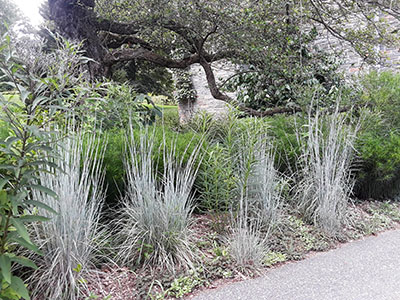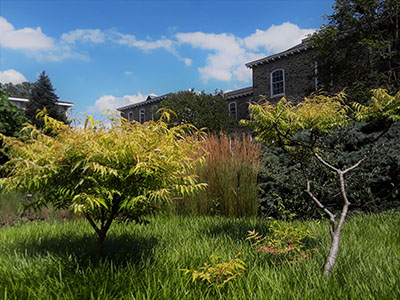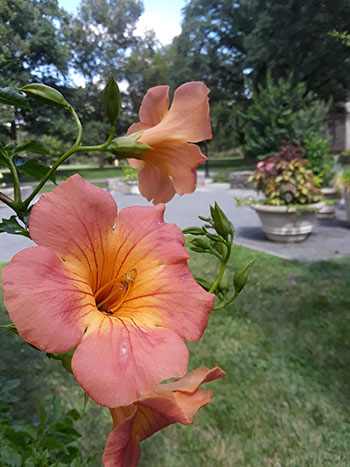
Plant of the Week: July 27

The dog days of summer are upon us and scarce rainfall is taxing many of our favorite plants. Though many gardeners may bemoan these conditions, I find solace in the rugged meadow plants which come into their own at this time of year, thriving under these cruel conditions. Echinacea, Asclepias, Eryngium and a host of grasses are putting on a spirited show. The collection of unique flowers and textures boast of bright and “hot” colors that are all too appropriate during this hot spell. These plants happily inhabit some of the toughest spots in the garden, save for soggy, shady spots. As such, their value in the summer landscape is unquestionable and should be celebrated during these sultry days when other plants pout. A favorite meadow plant of mine is Schizachyrium scoparium, known commonly as little bluestem.
Called such because of the notable blue coloration of the foliage, this grass actually flaunts many more colors than just blue. Bluish-green blades tinged with purple at the base emerge in May, are later adorned with handsome bronzy-purple flowers in July, then succeeded by silvery seedheads, extending the visual interest of this plant well into the winter. Yet, perhaps the most eye-catching moment occurs in the autumn, as the blades take on magenta and copper tones!
The effect of this multicolored grass is rather soft. It mingles among other plants creating a perfect splash of color and texture for the sunny border. Plants are about 2’ tall and wide, but reach closer to 4’ tall when in flower, adding an extra bit of late-season eccentricity to this unique foliage plant. S. scoparium prefers a full sun with medium to dry soils, although it is highly adaptable to different soil types.
‘Standing Ovation’ is a cultivar of little bluestem which offers wider foliage than the species, more sustained fall color, and a more rigid and upright habit when grown in richer soils. This grass looks outstanding right now, even prior to the emergence of flowers and seedheads, truly worthy of a standing ovation. You can find a number of S. scoparium ‘Standing Ovation’ plants throughout the Biostream (along with many other lovely meadow plants!) and around the Scott Entrance Garden, where the bright blue blades cannot be missed. photo credit: R. Payne-Meyer

Another tough plant that earns its keep throughout the trying, drying days of summer is Rhus typhina ‘Bailtiger’, typically sold under the name Tiger Eyes™. This cultivar of staghorn sumac features bright yellow foliage with very fine serration. As a sport of R. typhina ‘Laciniata’, the foliage of R. typhina ‘Bailtiger’ features much more finely divided leaflets than the R. typhina species. The foliage is quite fern-like and provides a soft appearance. The foliage emerges chartreuse deepening slightly to what remains shocking bright yellow; this plant is certainly an attention seeker.
R. typhina ‘Bailtiger’ plants look great when massed together, though it is an effective single specimen as well. Rather dwarf-like compared to the species, R. typhina ‘Bailtiger’ plants usually mature to around 5’, though they can grow larger and can be limbed-up into impressive tree-like specimens with a tropical air. Suckering will occur, (and can be desirable when planted en masse) though ‘Bailtiger’ is much less vigorous than what is typical of the R. typhina species, and much more controllable.
The autumn color is spectacular- shades of red orange and yellow which really stand out nicely on the finely divided leaflets. The female flowers produce lovely red pyramidal fruiting structures that start scarlet and mature to deep red in the winter, giving an extra bit of pizazz during the dull months of the year. Staghorn sumac plants are typically weedy in nature, growing along roads, railroad tracks, and thriving in urban areas. As such this plant is not fussy at all, preferring only a sunny spot and well-drained soil. I would highly recommend this plant to any gardener who seeks to brighten up a spot in the garden, you can’t go wrong with this selection! You can find R. typhina ‘Bailtiger’ in the John W. Nason Garden, where a number of plants grow together. photo credit: R. Payne-Meyer

Trumpetcreeper (Campsis sp.) has long been a favorite vine of mine, featuring attractive foliage and unique tropical-like tubular flowers which come in shades of red, yellow and my personal favorite flower color, orange. When I laid eyes on the peachy color of Campsis grandiflora ‘Morning Calm’, I could not well keep my calm, as I had found a new favorite floral tone to usurp my typical preference of a sharper orange.
Peachy petals show off varying degrees of orange and red and are accompanied by yellow throats on the flower’s interior, truly a spectacular sight. This Chinese analog to our native Campsis radicans, C. grandiflora is more well behaved in the garden, still vigorous but not so weedy and maintenance heavy. C. grandiflora ‘Morning Calm’ is also more compact than the C. grandiflora species, making it an excellent choice for smaller gardens, where it can be grown up vertical accents, across fences and walls, or on a trellis. Eventually this plant will still become quite large, so consider pruning yearly in late winter or early spring to keep a good shape and the size in check.
The serrated foliage is a lovely emerald color when young, deepening to lustrous dark green that looks great even without flowers. Campsis plants adapt to a range of soils and are fairly drought tolerant. While plants perform well in part-shade, a sunny location will allow for the most flower production. C. grandiflora ‘Morning Calm’ can be found livening up the Isabelle Cosby Courtyard, where it is trained and well shaped to a vertical post. photo credit: R. Payne- Meyer
Plan a visit to the Scott Arboretum today and you can see all of these exciting selections, along with other textural treats and summer blooming beauties!





Alex
Posted at 19:11h, 30 AugustIt was so lovely to hear about about these beautiful plants as summer is dwindling down. I particularly appreciate the peachy pink flowers of the Campsis ‘Morning Calm’. Thank you so much for this wonderful entry!